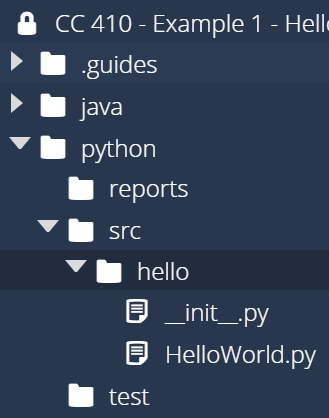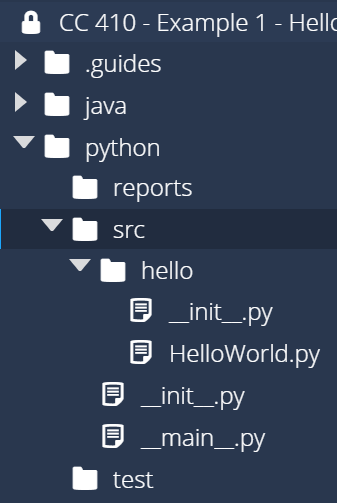Write Hello World
Now that we’ve created a package for our code, let’s write the code for our “Hello Real World” application. Traditionally, a Python “Hello World” program is a single line of code, but for this example we’ll follow all of the object-oriented standards by creating a class and a method.
Create a Class
First, we need to create a source code file for our application. We’ll place this code inside of the src/hello package we’ve already created. So, let’s create a file called HelloWorld.py in that directory. Once it is created, we should see the following structure:
Then, inside of that file, we can place the following code:
class HelloWorld:
@staticmethod
def main(args):
print("Hello World")This code should be pretty familiar at this point. The one thing to notice is that this file does not include a main guard. We do this for a couple of reasons:
- If the class is executed directly, it will simply load the class but there isn’t any code outside of the class that would actually be executed.
- We will use a different process to start our entire application, which we will detail below.
So, by using this structure, we can actually simplify our code a bit by omitting the main guard!
Make an Application
Next, we’ll need to create a couple more files in order to make our application easily executable. In fact, what we’ll end up doing is making the entire src folder act like a “meta package” that includes all of the packages in the application.
To do this, we’ll need to create two more files directly inside of the src folder:
__init__.py- this will make Python treat the entiresrcdirectory as a package__main__.py- this will allow Python to execute that package directly as an application
Once those files are created, we should have a structure similar to this image:
Then, we need to populate those files with some code. So, in the __init__.py file in src, enter the following code:
print("In /src/__init__.py")As before, this will just allow us to see when the package is loaded to help us understand how everything works together.
In the __main__.py file, we’ll put the following code:
import sys
from src.hello.HelloWorld import HelloWorld
print("In /src/__main__.py")
HelloWorld.main(sys.argv)Hopefully this code is also pretty easy to understand. We’ll import the sys library so we can access the command line arguments, and then we’ll also import our HelloWorld class from the src.hello meta package we created. Finally, we’ll print a message stating which file we are in, and then call the main method of our application, passing along the command line arguments.
The __main__.py file is described in the Python Documentation.
Run Our Application
That’s all we need to make our application usable. Now, let’s see if we can execute it.
To use our application, we’ll need to use the Linux terminal from within the python folder. So, let’s open the Linux terminal and change our directory to that location:
cd ~/workspace/pythonOf course, if you are already in the ~/workspace folder, you can just use cd python to get there. In the code above, we include the whole path so that it will always work, regardless of the current working directory.
Once we are in that directory, we can execute our application using the following command:
python3 -m srcThat will tell Python to execute the application stored in our src folder as a Python module, or meta package. When we do that, we should receive output like this:
As we can see, our application actually goes through a few steps before it is able to run the main function:
- First, Python finds the
srcmeta package, which will reach the print statement in__init__.py. It will then find__main__.pyand execute it to run the meta package as a program. - Then, the
src.hellopackage is loaded on line 2 of__main__.py. So, the__init__.pyfile in that package will be loaded and executed. - Next, we reach the print statement on line 3
__main__.py. - Finally, line 4 of
__main__.pyexecutes themainfunction of ourHelloWorldclass
There we go! We’ve successfully built and run our application using Python! If you want, you can test different messages in HelloWorld.py to make sure the program is working correctly.
Pycache Folders
When Python code is executed, the Python interpreter creates a “compiled” version of the code and stores it in a folder called __pycache__. Those folders can be safely ignored, but they may appear in various directories as you develop and test your application. Later in this module we’ll discuss how to omit those directories from version control applications such as Git.
You can read more about this process in the Python Documentation.


